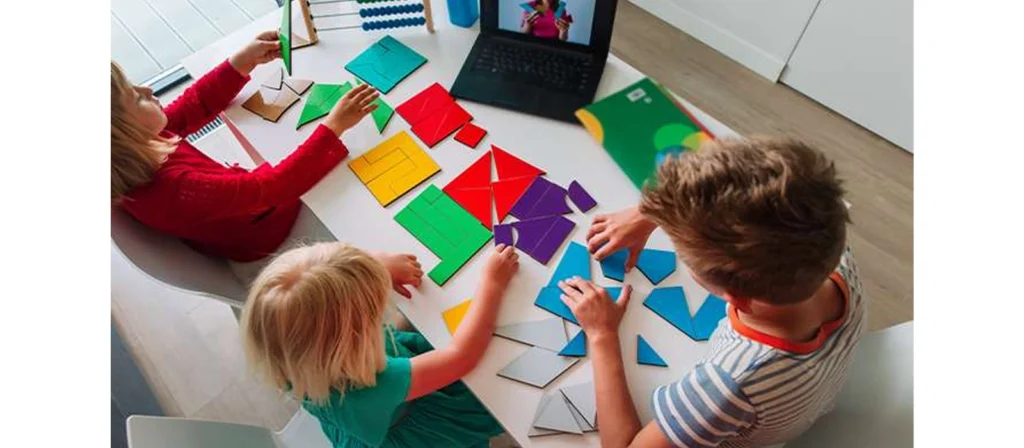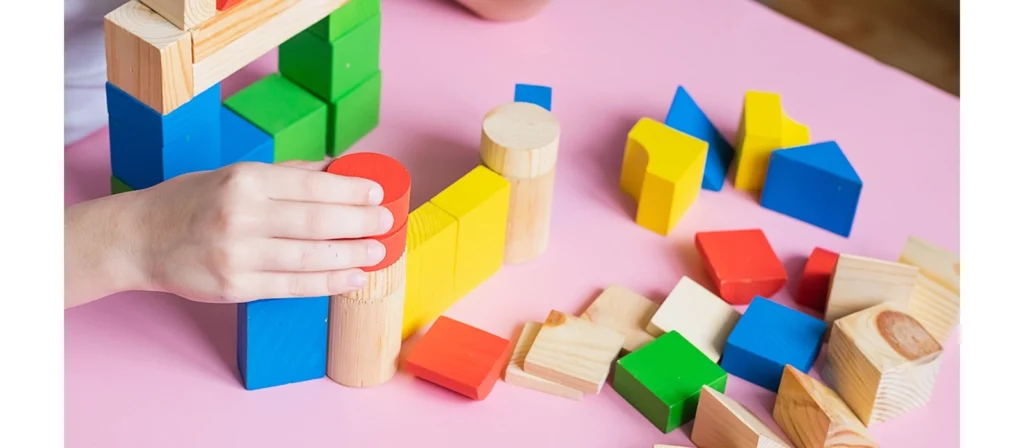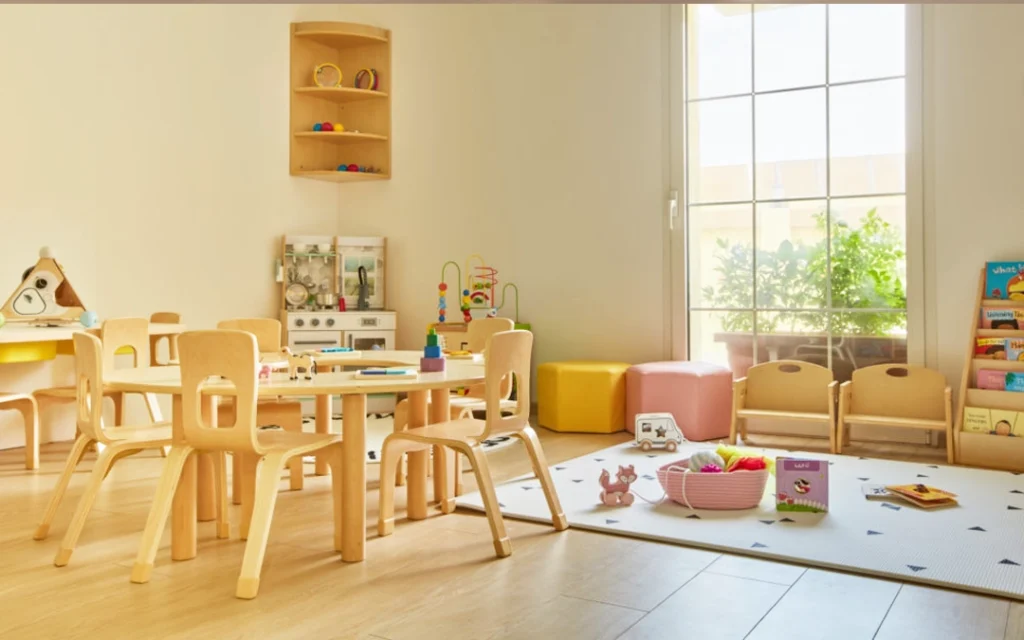Research shows that more than 80% of learning processes rely on visual and spatial abilities. In other words, whether a child can understand maps, shapes, and relationships between objects largely depends on their Visual Spatial Intelligence. However, this ability is often underestimated in early education until difficulties arise in subjects such as math, science, or art.
Visual Spatial Intelligence is the capacity to process visual information, understand spatial relationships, and mentally manipulate objects. In early education, it provides the foundation for problem-solving, creativity, and STEM learning.
For example, in the same kindergarten, Jack can easily complete 3D block building, imagining a castle and then constructing it with his hands. Meanwhile, Mary struggles with the same task, often confusing directions and positions, needing additional guidance from the teacher. This is not a matter of intelligence levels, but rather a difference in the stage of visual spatial intelligence development.
This difference reminds us that visual spatial intelligence not only determines how children perform in play but also directly shapes how they learn and grow in the future. Understanding and cultivating this ability has become an essential concern for educators, parents, and even those who design kindergarten environments.
What is Visual Spatial Intelligence?
Visual spatial intelligence refers to the ability to perceive, analyze, and mentally manipulate visual patterns and spatial relationships. It was first highlighted by Howard Gardner in his theory of multiple intelligences [placeholder link]. Unlike linguistic or logical-mathematical intelligence, this form of intelligence is grounded in how individuals understand space, form, distance, and orientation.

Children with strong visual spatial intelligence can easily visualize how objects fit together, recognize patterns, and imagine transformations of shapes. For example, they may quickly grasp how puzzle pieces connect, or how a series of blocks can form a bridge. On the other hand, children with underdeveloped spatial skills might struggle with direction, navigation, or interpreting diagrams.
Visual spatial intelligence is not limited to artistic expression. It plays an essential role in subjects such as geometry, physics, and even reading comprehension, where visualization of concepts improves understanding. In early education, recognizing the importance of this intelligence helps teachers tailor learning environments that promote exploration and creativity.
It is also worth noting that visual spatial intelligence develops differently among children. Some naturally excel in it, while others require guided practice and supportive environments. Educators and parents must work together to identify these differences early on, ensuring that no child is left behind in developing this fundamental capacity.
Visual Spatial Intelligence Meaning in Education
Role in Early Learning
Visual spatial intelligence plays a crucial role in how children learn and process new information in school. In early education, this form of intelligence allows children to organize their thoughts, understand abstract ideas through images, and interpret the physical environment around them. A child with strong spatial skills may use mental maps to navigate their classroom, or visualize story sequences when listening to a teacher read aloud.
Beyond Academic Performance
The meaning of visual spatial intelligence in education extends beyond academic performance. It shapes creativity, problem-solving, and confidence in exploring new ideas. When children can visualize solutions, they are more likely to approach challenges with curiosity instead of fear. For example, a child solving a math problem may imagine the numbers as blocks being rearranged, making abstract operations more concrete.
Classroom Design and Teaching Strategies
Classroom design and teaching strategies can either enhance or hinder the development of this intelligence. For instance, an open, flexible classroom layout with accessible furniture allows children to experiment with space and movement. On the other hand, rigid seating arrangements can limit exploration. Teachers can integrate drawing, model-making, and map-reading into lessons to ensure that visual and spatial learners are engaged.
Supporting Children with Lower Skills
Educators must also recognize that children with lower visual spatial skills may feel frustrated when tasks rely heavily on diagrams or construction. Providing supportive tools such as visual aids, graphic organizers, or hands-on activities helps bridge this gap. This approach ensures that every child has the opportunity to strengthen their spatial abilities.
Long-Term Educational Impact
Ultimately, understanding the meaning of visual spatial intelligence in education underscores the need for balanced teaching methods. It emphasizes that intelligence is not one-dimensional and that nurturing spatial thinking can empower children to succeed not only in school but also in their lifelong learning journey.
Visual Spatial Intelligence Examples
Everyday Examples in Children’s Lives
Children show their visual spatial intelligence in daily activities such as assembling puzzles, building with blocks, or drawing pictures. A child who quickly understands how puzzle pieces fit together or who enjoys designing elaborate LEGO structures demonstrates strong spatial reasoning. These everyday tasks reflect their natural ability to perceive and manipulate space.

Examples in Classroom Learning
Visual spatial intelligence often surfaces during geometry lessons, map-reading, or science experiments. For instance, children may be asked to draw a floor plan of their classroom, identify shapes in their environment, or visualize how planets orbit the sun. These activities highlight their ability to translate abstract concepts into mental images.
Examples in Play and Creativity
Creative play reveals spatial strengths. A child designing a racetrack with toy cars, sketching animals, or constructing models shows their ability to mentally plan and execute ideas in physical form. Such play activities not only entertain but also sharpen problem-solving and design skills.
Examples in Early Education Environments
Kindergarten settings offer numerous opportunities to foster spatial intelligence. Classroom furniture arrangement, play corners with building toys, and art stations provide children with rich contexts to practice visual and spatial reasoning. Teachers can guide children to see patterns, recognize proportions, and understand distances.
Long-Term Implications
The examples of visual spatial intelligence are not limited to early education. They also lay the foundation for future skills in STEM, art, and design. Recognizing these signs early can help educators and parents support a child’s potential career paths in fields such as engineering, architecture, or graphic design.
Visual Spatial Intelligence Test
Purpose of Testing
Visual spatial intelligence tests are designed to measure a child’s ability to visualize, interpret, and manipulate spatial relationships. These tests help educators and parents identify strengths and weaknesses in a child’s spatial reasoning skills.
Common Test Formats
Typical assessments include puzzle completion, pattern recognition, and block design tasks. Some tests may ask children to rotate shapes mentally, identify hidden figures within complex images, or replicate models using blocks. These exercises reveal how well children can process and transform visual information.
Examples of Standardized Tests
Widely used assessments include the Block Design subtest of the Wechsler Intelligence Scale for Children (WISC) and the Differential Aptitude Test (DAT) [placeholder link]. These tools provide structured insights into a child’s visual spatial capabilities and can guide targeted interventions.
Practical Test Activities for Preschool
Below is a table with simple and playful assessments that can be applied in preschool settings:
| Test Activity | Description |
|---|---|
| Shape Rotation Game | Show a 2D shape and ask the child to identify it after rotation. |
| Pattern Blocks | Provide colored blocks and ask children to replicate a given pattern card. |
| Hidden Object Search | Use picture books or worksheets where children must find hidden figures. |
| Memory Mapping | Let children study a simple classroom map, then draw it from memory. |
| LEGO Construction Challenge | Show a simple LEGO model and ask the child to reproduce it. |
These small-scale tests can be done within classrooms or at home and give educators practical insights into a child’s development.
Informal Classroom Assessments
In everyday classrooms, teachers can observe children during hands-on activities such as drawing, constructing, or navigating classroom layouts. These informal assessments provide valuable real-time feedback about a child’s spatial reasoning.
Benefits of Testing
Understanding a child’s performance on visual spatial intelligence tests allows educators to adapt teaching strategies. It can highlight the need for more visual aids, hands-on projects, or spatial reasoning games, ensuring that learning experiences match a child’s strengths.
Developing Visual and Spatial Intelligence in Preschool
Role of the Learning Environment
Preschool environments play a critical role in nurturing visual spatial intelligence. Open spaces, flexible seating, and easily accessible play areas encourage children to explore and experiment with their surroundings. Furniture designed for early learners should support creativity and allow for movement and reconfiguration.
Hands-On Activities
Practical activities are essential for strengthening spatial skills. Examples include:
- Building with blocks, LEGO, or magnetic tiles
- Engaging in drawing, coloring, and painting
- Creating models with clay or other manipulatives
- Participating in treasure hunts or obstacle courses that require navigation
Teacher-Led Strategies
Teachers can integrate spatial reasoning into lessons through:
- Storytelling with visual aids and props
- Using maps and simple charts to explain ideas
- Encouraging children to describe the position of objects (e.g., above, below, next to)
- Guiding collaborative construction projects where children must plan and build together
Family Involvement
Parents can extend these strategies at home by:
- Providing puzzles and building kits
- Encouraging children to help with simple tasks like setting the table (spatial arrangement)
- Playing board games that require movement across grids
- Involving children in simple household organization activities
Long-Term Benefits
Developing visual and spatial intelligence in preschool helps children gain confidence, problem-solving skills, and creativity. These abilities prepare them for future academic challenges in STEM and the arts, while also equipping them with life skills that extend beyond the classroom.
Applications of Spatial-Visual Intelligence in Kindergarten Furniture
Importance of Furniture Design
Furniture arrangement in kindergartens is more than a matter of comfort; it directly influences how children perceive and interact with their environment. Well-designed spaces help children explore distances, directions, and proportions, thereby enhancing their visual spatial intelligence.

Flexible Classroom Layouts
Movable tables, modular seating, and adjustable shelves encourage children to experiment with space. A classroom where furniture can be reconfigured supports group collaboration, creative projects, and spatial exploration.
Learning Corners and Play Zones
Designating specific areas—such as block-building zones, art stations, and reading nooks—helps children practice organizing and navigating space. Each corner becomes an opportunity for children to apply spatial reasoning while engaging in hands-on learning.
Role of Safe and Scaled Furniture
Child-sized chairs, low tables, and open shelves not only provide comfort but also allow children to move independently. This autonomy fosters exploration of their environment, which strengthens both spatial awareness and problem-solving abilities.
Integration with Educational Tools
Furniture can be paired with tools such as puzzles, building blocks, and interactive boards. For example, a round table can double as a space for collaborative construction projects, encouraging children to think in multiple dimensions.
Case Example from Preschool Settings
In one kindergarten project [placeholder link], rearranging furniture into thematic zones improved children’s ability to understand directions and sequences. Teachers reported that children showed greater creativity in storytelling, stronger collaboration, and improved navigation skills.
Long-Term Value
Furniture design that incorporates principles of spatial-visual intelligence not only improves immediate classroom engagement but also lays a foundation for children’s future learning in mathematics, science, and the arts.
Visual Spatial Intelligence in Digital Age
Digital Tools and Learning Apps
The rise of digital technology has introduced new ways to nurture visual spatial intelligence. Learning apps that use interactive puzzles, 3D modeling, and virtual environments allow children to practice spatial reasoning in engaging formats. Augmented reality (AR) and virtual reality (VR) tools are increasingly being integrated into classrooms to simulate real-world spatial challenges [placeholder link].
Clipart and Visual Resources
Digital clipart, graphics, and visualization tools support teachers in creating visually rich lessons. Children benefit from exposure to diagrams, infographics, and interactive images, which help them process and retain abstract concepts. For example, using clipart of geometric shapes can simplify the introduction of complex math ideas.
Video Games and Gamification
Educational video games designed around navigation, building, or spatial problem-solving also enhance children’s visual spatial intelligence. Games that require map-reading, construction, or strategy encourage children to think critically and manipulate space in real time.
Opportunities and Challenges
While digital tools expand opportunities for learning, educators must balance screen time and ensure that technology is used purposefully. Excessive or unguided use of digital devices may limit real-world spatial exploration. Therefore, integrating digital resources should complement, not replace, hands-on experiences.
Future Directions
The digital age offers vast potential to personalize learning. Adaptive learning platforms can assess a child’s visual spatial intelligence and provide tailored activities to strengthen weak areas. As technology evolves, it will continue to shape how educators and parents nurture spatial skills.
Visual/Spatial Intelligence and Future Learning Skills
Link to STEM Education
Visual/spatial intelligence forms the backbone of STEM subjects. Skills like geometry, physics, engineering, and computer programming all rely on the ability to visualize and manipulate spatial information. Children with strong visual spatial skills tend to perform better in problem-solving and innovation within these areas.
Connection to Creative Fields
Beyond STEM, visual spatial intelligence is equally critical in art, architecture, and design. Future careers in graphic design, urban planning, and multimedia production demand high levels of spatial reasoning. Early development of these skills can unlock pathways into creative industries.
Role in 21st Century Skills
Critical thinking, collaboration, and innovation—often labeled as 21st-century skills—are reinforced by visual spatial intelligence. Being able to imagine different perspectives, plan solutions, and visualize outcomes equips children to thrive in rapidly changing environments.
Preparing for Future Careers
As the workplace becomes increasingly technology-driven, careers in robotics, AI, and data visualization will require strong spatial reasoning. Training children in spatial skills from an early age ensures they are prepared to navigate future challenges and opportunities [placeholder link].
Lifelong Learning Benefits
Developing visual/spatial intelligence does not only serve professional goals. It enhances daily life skills such as navigation, planning, and organization. Strong spatial thinkers are better at understanding directions, managing tasks, and adapting to new environments.
Conclusion
Visual spatial intelligence is not just an educational concept—it is a vital life skill that influences how children see, think, and interact with the world. When educators and parents intentionally nurture this ability through classroom design, playful learning, and digital tools, children develop stronger problem-solving, creativity, and confidence. These skills serve as stepping stones into STEM, the arts, and everyday life tasks.
For preschools and kindergartens, investing in the right environment is critical. At XIHA Furniture, we believe that thoughtfully designed furniture and learning spaces can unlock children’s visual and spatial potential. Our child-scaled tables, chairs, storage systems, and play zones are created not only for comfort and safety, but also to encourage exploration, imagination, and collaboration. By combining quality materials with educational insight, we help schools create spaces where visual spatial intelligence can thrive.
As research continues to show, nurturing spatial-visual intelligence from the earliest years lays the foundation for lifelong learning and future career success. By choosing the right tools, resources, and environments—including durable and innovative preschool furniture from XIHA—you empower children to reach their fullest potential.



